Excerpts from Jim Conrad's
Naturalist Newsletter
from the January 11, 2019 Newsletter issued from Rancho Regensis north of Valladolid, Yucatán, MÉXICO;
elevation ~40m (~130 ft), N~20.876°, W~88.170°
SQUARE-STEMMED MISTLETOE
Beside the garden, suspended among the lower branches of the very common tree sometimes in English called the Bay Cedar (Guazuma ulmifolia), which it parasitizes, there's a healthy bunch of mistletoe about the size of washing machine, as shown below:
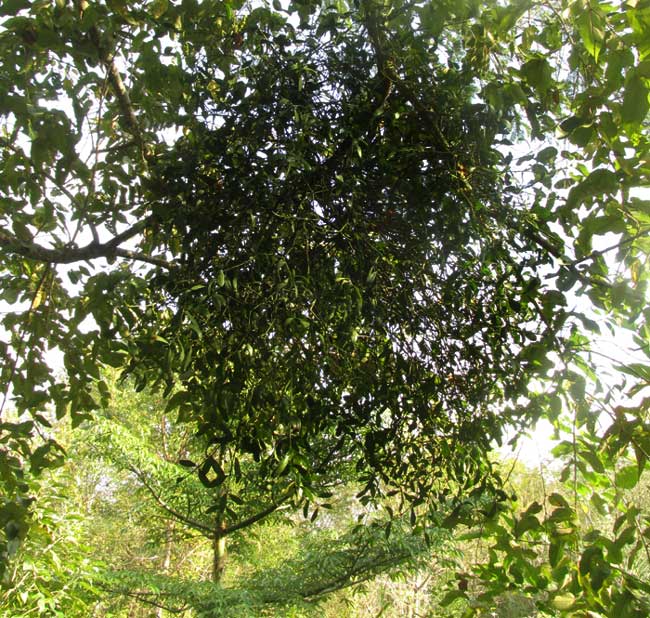
Mistletoes can be hard to identify, so I've been looking forward to seeing this clump bearing fruit, and now it is. Below, you can see its small, waxy, yellowish fruits:

The leaves' bases gradually diminish toward their attachment point with the stem, and are oddly curved and puckered, as shown below:
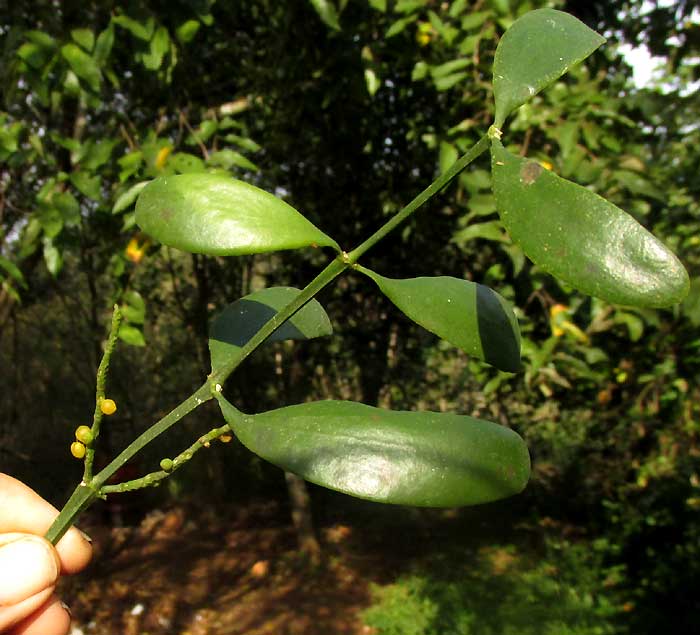
In that picture, notice the stem. It looks squared in cross section, and tends to enlarge below each leaf-bearing node. A stem's sharp angularity is nicely shown below:
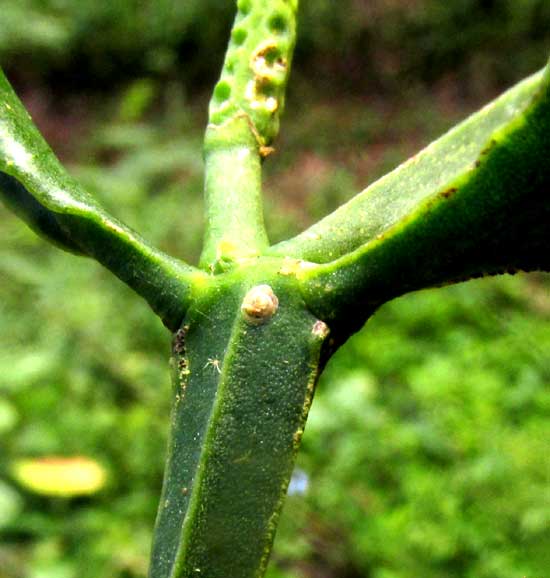
A mature fruit 3mm in diameter (1/10inch) is seen below:

Such quadrangular stems is uncommon among the mistletoes, so it was relatively easy to determine that our gardenside species is PHORADENDRON QUADRANGULARE, which doesn't seem to have a good English name, though with its species name of quadrangulare it almost names itself "Square-stemmed Mistletoe." The species is common throughout the American tropics, from northern Mexico and the Caribbean south to northern Argentina, often growing on trees in disturbed, weedy areas, as was the case with ours.
Phoradendron quadrangulare is reported to parasitize not only Bay Cedars but also various members of the Bean Family, as well as Chinaberries, Forestieras and other diverse species.
Mistletoe species occur throughout most of the world and as a group have a long history of traditional use as folk medicine. In her 2014 PhD dissertation on the feeding of Spider Monkeys on mistletoe leaves Lynda Ann Rostron tells us that " The biological effects of mistletoe extracts include cytotoxicity, apoptosis, tumour inhibition, induction of immune processes and antioxidant activity." She also points out that cultures worldwide have treated diabetes with it. There's no mention of treating toothache there, but maybe its "induction of immune processes and antioxidant activity" might be helpful.
Rostron's Spider Monkeys in Costa Rica, by the way, fed on our square-stemmed Phoradendron quadrangulare, though other mistletoe species were available.
from the January 18, 2019 Newsletter issued from Rancho Regensis north of Valladolid, Yucatán, MÉXICO;
elevation ~40m (~130 ft), N~20.876°, W~88.170°
JUAN'S TOOTHACHE, WEEK TWO
Last week I described how our Maya worker Juan came to work with his cheek swollen from a tooth-ache, the cheek plastered with pieces of medicinal herb. He called the commonly occurring herb Hool-k'iim. It was Talinum paniculatum, and its story with pictures appears on our Talinum paniculatum page at www.backyardnature.net/yucatan/talinum.htm
This week Juan got more serious about treating his pain by concocting a green paste made of three locally common herbs, and he was kind enough to let me document his various doings. His using three herbs instead of one sounds right to me because curanderos, or healers, I've known seldom relied on a single ingredient for their medicines. Their treatments usually consisted of three or more components.
First we went to the same place as before, to pick more Talinum paniculatum leaves. Then we walked just a few feet, to the other side of the shaded compost area, and picked a few leaves of Leaf-flower, Phyllanthus amarus, which we've profiled at www.backyardnature.net/yucatan/leafflwr.htm
Below, you can see Juan collecting his Leaf-flower leaves:
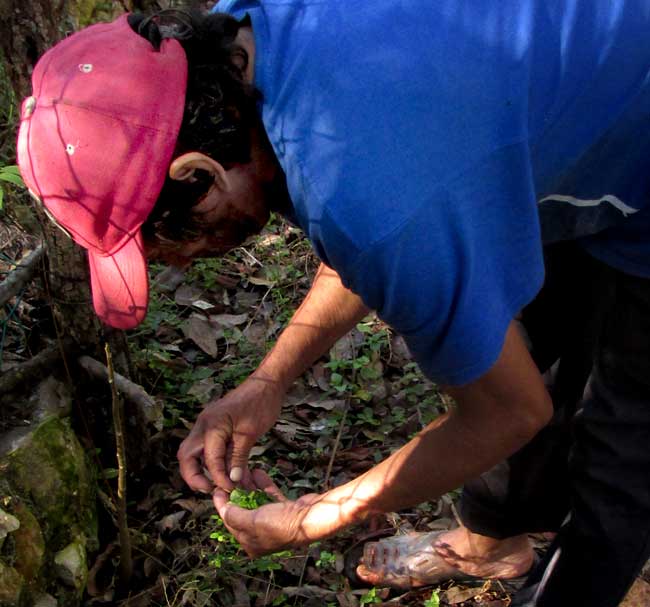
Notice that Juan isn't picking the whole plant, just removing leaves. The slender, wiry stem of Phyllanthus amarus is semi-woody, so Juan placed the stem between two fingers and raked upward, the leaves coming off individually. "Now the stem will grow new leaves," he said.
Next we gathered a few leaves of Square-stemmed Misteletoe, Phoradendron quadrangulare, parasitizing a nearby Bay Cedar, Guazuma ulmifolia. Our Square-stemmed Mistletoe page is at www.backyardnature.net/yucatan/mistlet3.htm
Below, you can see the entire collection of leaves from the three above species:

On the picture's left side, the larger leaves at the bottom are from Talinum paniculatum. Atop them lie the Leaf-flower's leaves, and on the right side of the picture you see the mistletoes's blades.
On our pages for the above plants we've already noted that these species are recognized widely as medicinal plants. Studies have shown that, in rats, extracts of roots and leaves of Talinum paniculatum produced "estrogenic activity... which can be helpful in managing reproductive tissues regression during menopause... " Extracts of the Square-stemmed Mistletoe affect "cytotoxicity, apoptosis, tumour inhibition, induction of immune processes and antioxidant activity." Leaf-flower is much used in India's Ayurvedic system of medicine for a long list of problems, including, gonorrhea and other genital afflictions, diarrhea, dysentery, intermittent fevers, ophthalmopathy, scabies, ulcers and general wounds."
Now it was time to mash the leaves into a green paste. Normally Juan uses as a grinding bowl, or morter, half of a gourd-like jícara fruit from what's sometimes called the Calabash Tree (Crescentia cujete. That interesting tree is profiled at www.backyardnature.net/yucatan/calabash.htm
However, Juan's jícara was filled with something else, so he used the bottom of a liter-size Coca-Cola plastic bottle, as shown below:
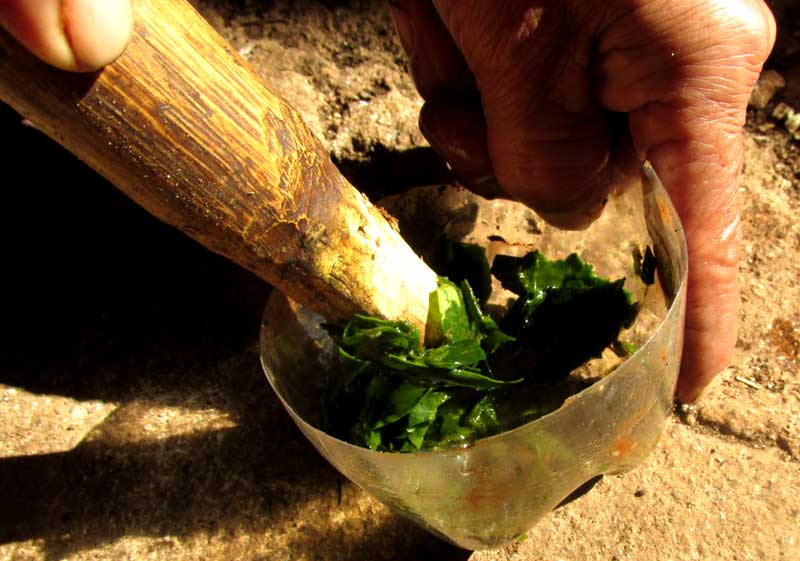
The grinder, or pestle, is just a solid piece of a young tree trunk quickly carved with a machete blade.